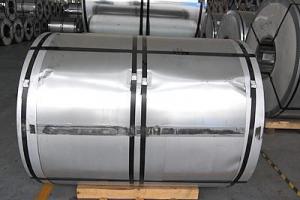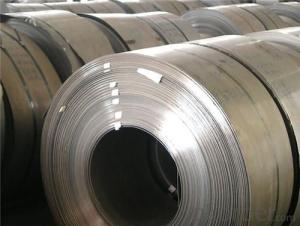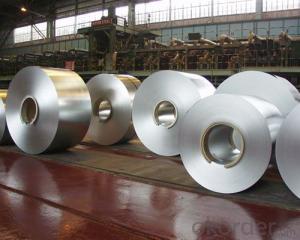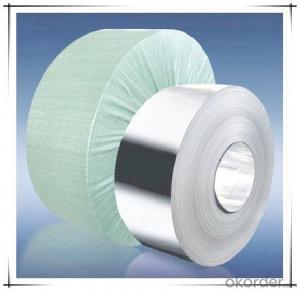PRIME QUALITY 430 STAINLESS STEEL IN COIL
- Loading Port:
- China main port
- Payment Terms:
- TT OR LC
- Min Order Qty:
- 20 m.t.
- Supply Capability:
- 1000 m.t./month
OKorder Service Pledge
OKorder Financial Service
You Might Also Like
Applications of Stainless Steel Coils:
1.Automotive:Automotive trim and molding/Difficult-to-form exhaust-system components, tubular manifolds, mufflers/Exhaust manifold and other exhaust-system components, catalytic converter shells, clamps
2. Construction: Gutters and downspouts, roofing, siding
3. Kitchenware: Cooking utensils, dishwashers, ovens, range hoods, refrigerators, skewers
4. Chemical processing: Oil refinery equipment, oil burner and heater parts
5. Appliances: Hot water tanks, residential furnaces
6. Power generation: Heat Exchanger tubing
7. Farming: Dry fertilizer spreaders/Farm animal pens
Technical notes:
Packaging & Shipping
Packaging is one of the best service of us, in order to prevent the damage from transit, our finished products are packaged carefully. All of our stainless steel sheet products will be transported with steel pallets or wooden pallets. Customers will be guaranteed that the product .they received from Ronsco can go directly into the production and out to the customers as finished product.
- Q:How are stainless steel strips different from carbon steel strips?
- Stainless steel strips and carbon steel strips differ in various aspects, making them suitable for different applications. The main distinction lies in their composition and the presence of additional elements. Stainless steel strips are primarily composed of iron and chromium, with the addition of other elements such as nickel, molybdenum, and manganese. This composition gives stainless steel its corrosion-resistant properties, making it ideal for applications where exposure to moisture or chemicals is expected. Additionally, stainless steel strips possess excellent heat resistance, making them suitable for high-temperature environments. On the other hand, carbon steel strips consist mainly of iron and carbon, with minimal amounts of other elements. Carbon steel is known for its strength and durability, making it suitable for applications that require high tensile strength and hardness. However, carbon steel is susceptible to corrosion, especially when exposed to moisture or certain chemicals. Another key difference between stainless steel and carbon steel strips is their appearance. Stainless steel has a distinct silver-gray color and a smooth, shiny surface, giving it an aesthetically pleasing look. Carbon steel, on the other hand, usually has a duller appearance, with a rougher surface texture due to the presence of impurities. Furthermore, stainless steel strips are more expensive than carbon steel strips due to the additional elements used in their composition, as well as their superior corrosion resistance and other properties. This cost difference is an important consideration when choosing between the two materials for a specific application. In summary, stainless steel strips and carbon steel strips differ in terms of their composition, corrosion resistance, heat resistance, appearance, and cost. Understanding these differences is crucial in selecting the appropriate material for a particular application, ensuring optimal performance and longevity.
- Q:Can 111 stainless steel strips be coated with anti-corrosion paints?
- Yes, 111 stainless steel strips can be coated with anti-corrosion paints. Stainless steel is generally resistant to corrosion, but applying an additional layer of anti-corrosion paint can provide added protection against environmental factors and extend the lifespan of the strips.
- Q:How do you measure the hardness of a stainless steel strip?
- The hardness of a stainless steel strip can be measured using various methods, but the most commonly used method is the Rockwell hardness test. This test involves using a diamond cone or a hardened steel ball indenter to penetrate the surface of the strip under a specific load. The depth of indentation is then measured, and a hardness value is determined based on the Rockwell scale. To conduct the Rockwell hardness test, the stainless steel strip is securely placed on a testing machine with a flat and smooth surface. The indenter is then brought into contact with the surface of the strip, and a preliminary load is applied to set the initial position of the indenter. Once the preliminary load is set, the final load is applied, and the indenter penetrates the surface to a certain depth. After removing the load, the resulting indentation is measured using a microscope or an optical measuring device. The hardness value is determined by taking the difference between the depth of penetration under the final load and the depth of penetration under the preliminary load. This value is then converted to a Rockwell hardness number using a chart or a digital display on the testing machine. It is worth mentioning that the Rockwell hardness test provides a measure of the material's resistance to indentation, which is an indirect indication of its mechanical properties such as strength and toughness. Other methods, such as the Vickers or Brinell hardness tests, can also be used to measure the hardness of stainless steel strips, depending on the specific requirements and characteristics of the material.
- Q:Can stainless steel strips be machined?
- Yes, stainless steel strips can be machined.
- Q:Can stainless steel strips be used for food storage containers?
- Absolutely! Food storage containers can make excellent use of stainless steel strips. Stainless steel is a highly favored option for these containers because of its exceptional durability, resistance to corrosion, and non-reactive nature. It offers the advantage of not transferring any unwanted taste or odor to the food being stored, making it a reliable choice for various types of edibles. Furthermore, stainless steel proves to be effortlessly cleanable and maintainable, ensuring a hygienic environment for food storage. Nevertheless, it is crucial to ensure that the stainless steel strips utilized in these containers meet the necessary food-grade quality standards for the sake of safety.
- Q:Are stainless steel strips suitable for decorative etching?
- Indeed, stainless steel strips prove to be fitting for decorative etching purposes. The versatility of stainless steel allows for the etching and engraving of elaborate and intricate designs and patterns. Its polished and smooth surface lends itself perfectly to the creation of detailed and visually captivating decorative etchings. Moreover, stainless steel exhibits exceptional durability and resistance to corrosion, ensuring the longevity of the etched designs. This quality has made stainless steel strips a favored option for a multitude of decorative applications, including signage, jewelry, art pieces, and architectural elements.
- Q:Do you have stainless steel with magnetic?
- The chromium content of ferritic stainless steel (400 Series) is 15%~30%, and has the structure of body centered cubic crystal. This kind of steel does not contain nickel, sometimes also contain a small amount of Mo, Ti, Nb and other elements, this kind of steel has high heat conductivity, low expansion coefficient, good oxidation resistance and anti stress excellent characteristics of stress corrosion, used formanufacturingthecorrosionresistanceofthe atmosphere, water vapor, waterandoxidizing parts.
- Q:How do stainless steel strips resist crevice corrosion in seawater?
- The unique chemical composition and passive protective layer of stainless steel strips make them resistant to crevice corrosion in seawater. Stainless steel primarily consists of iron, chromium, and other alloying elements like nickel and molybdenum. The presence of high chromium content, typically above 10.5%, is crucial in preventing crevice corrosion. When stainless steel strips come into contact with seawater, the chromium in the alloy reacts with oxygen to create a thin, transparent oxide layer on the surface, known as the passive layer. This passive layer is highly resistant to corrosion, including crevice corrosion. It acts as a protective barrier between the metal and the corrosive environment, preventing the initiation and spread of corrosion in crevices or tight spaces. The passive layer has the ability to self-heal. If it is damaged or removed, it can quickly reform in the presence of oxygen. This characteristic ensures long-term protection against crevice corrosion in seawater, even in challenging marine environments where the metal is constantly exposed to chloride ions and other aggressive elements. Moreover, the addition of alloying elements such as nickel and molybdenum further enhances the corrosion resistance of stainless steel strips. Nickel improves the stability and durability of the passive layer, while molybdenum enhances the alloy's ability to resist pitting and crevice corrosion in chloride-rich environments like seawater. In conclusion, the resistance of stainless steel strips to crevice corrosion in seawater is due to the formation of a protective passive layer on their surface. The high chromium content, along with other alloying elements, enhances the corrosion resistance and durability of the material, making it an excellent choice for various marine applications.
- Q:Can stainless steel strips be used in heat-resistant furnaces?
- Yes, stainless steel strips can be used in heat-resistant furnaces. Stainless steel is known for its high temperature resistance, making it suitable for use in furnaces that require heat-resistant materials. It has excellent oxidation resistance, which enables it to withstand high temperatures without corroding or deforming. Additionally, stainless steel has good thermal conductivity, allowing it to distribute heat evenly throughout the furnace. Its durability and strength also make it a reliable choice for withstanding the harsh conditions inside a heat-resistant furnace. Overall, stainless steel strips are a suitable material for use in heat-resistant furnaces due to their high temperature resistance, corrosion resistance, thermal conductivity, and durability.
- Q:How do stainless steel strips perform in high-temperature steam?
- Stainless steel strips are renowned for their exceptional performance in high-temperature steam settings. Thanks to their unique composition, these strips offer remarkable resistance to corrosion, even when confronted with aggressive steam conditions. The presence of chromium in stainless steel results in the formation of a protective layer of chromium oxide on the strip's surface. This layer acts as a formidable barrier, preventing corrosion and averting any interaction with the steam. Remarkably, this protective layer remains stable even under elevated temperatures, thus ensuring that the integrity and performance of the stainless steel strips are upheld in steam environments. Furthermore, the high strength and toughness of stainless steel strips enable them to withstand the mechanical stresses and pressures associated with high-temperature steam applications. In summary, stainless steel strips are a dependable and enduring choice for deployment in high-temperature steam environments, offering long-lasting performance and corrosion resistance.
1. Manufacturer Overview |
|
|---|---|
| Location | |
| Year Established | |
| Annual Output Value | |
| Main Markets | |
| Company Certifications | |
2. Manufacturer Certificates |
|
|---|---|
| a) Certification Name | |
| Range | |
| Reference | |
| Validity Period | |
3. Manufacturer Capability |
|
|---|---|
| a)Trade Capacity | |
| Nearest Port | |
| Export Percentage | |
| No.of Employees in Trade Department | |
| Language Spoken: | |
| b)Factory Information | |
| Factory Size: | |
| No. of Production Lines | |
| Contract Manufacturing | |
| Product Price Range | |
Send your message to us
PRIME QUALITY 430 STAINLESS STEEL IN COIL
- Loading Port:
- China main port
- Payment Terms:
- TT OR LC
- Min Order Qty:
- 20 m.t.
- Supply Capability:
- 1000 m.t./month
OKorder Service Pledge
OKorder Financial Service
Similar products
New products
Hot products
Related keywords































